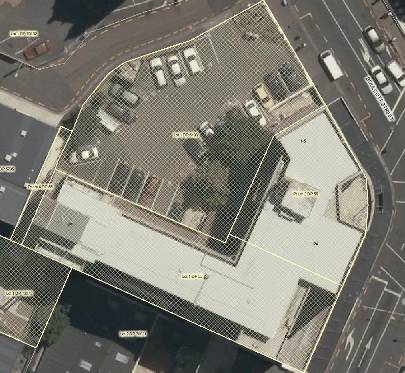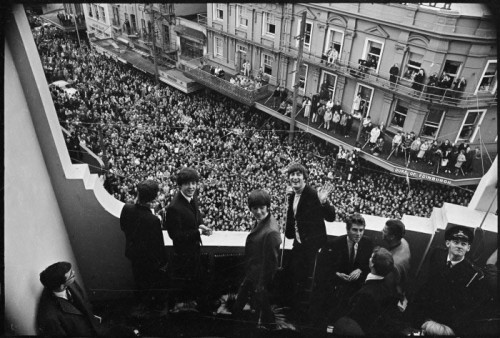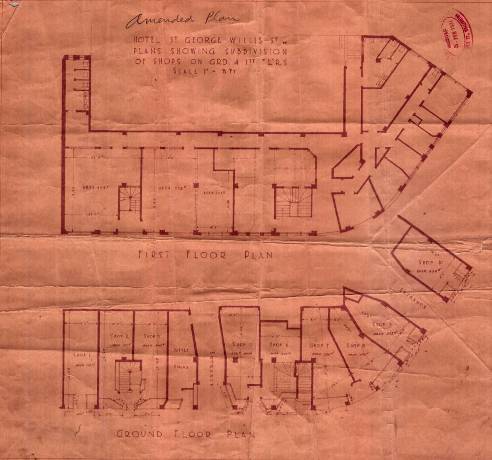Hotel St George
Hotel St George, Majestic Hotel, Albert Hotel
-
Constructed
1929 - 1930
-
-
Architect(s)
-
Builder(s)
Unknown
-
Hotel St George is one of Wellington’s outstanding art deco buildings. Note its well-proportioned facades, restrained art deco ornamentation and how it ‘turns-the-corner’ from Boulcott to Willis Street.
The landmark building has a steel frame and reinforced concrete – the best structural system of the time – a system proven to be earthquake-resistant overseas.
The hotel has hosted the likes of Alfred Hitchcock, Jean Batten, Henry Ford, Laurence Olivier, The Beatles, and American Marines. It is now student and backpacker accommodation
-
Downloadable(s)
-
close
History
-
The Hotel St George is a significant Wellington Hotel sited on a prominent corner in the middle of the Wellington Central City. It has an interesting Art Deco façade which is split in the middle, leaving separate but identical elevations to Willis and Boulcott Streets. It was a prominent hotel in Wellington and at the time was called a ‘boon to travelling public’, ‘the Southern Hemisphere’s most palatial Hotel, and was noted as being able to ‘vie with anything to be found in the Old Country, on the Continent of Europe, or in the United States’.
This site has been occupied by a building since the 1850s. The site had been purchased by the Hon. F. J. Tollemache, who sold it on to the United Bank of Australia in 1851. The bank constructed banking premises on the site, with a manager’s residence, carriage house, and stables. The building was erected by Mr. James Wilson, under the supervision of Mr. E. Roberts, a clerk of works to the Royal Engineers. This was rebuilt following the 1855 earthquake which had left the building in ruins. In 1877 John Plimmer purchased the building and converted it into the Albert Hotel, adding a storey to the Willis Street frontage to accommodate suites. At the time it was noted that the hotel would ‘when completed will be equal, if not superior’ to all others in the area. The hotel remained for many years but in 1929 it was decided that a new hotel that would be worthy of the capital city and the exceedingly valuable site that it occupies was needed.
Demolition of the old Albert Hotel commenced in 1929 and construction of the St George began. Construction was carried out by Hansford and Mills to plans designed by William John Prouse. The building was heralded as being a marked advance upon other buildings in the city. The design was influenced by the Art Deco style that was popular at the time, but it was the construction methods that were the real improvement. The building was constructed with a steel frame and reinforced concrete – the best available structural-system of the time – and a system that had been proven to be earthquake-resistant in San Francisco and Japan. These were new techniques in New Zealand hotel building and were regarded as being extremely innovative. The Hotel was originally intended to be called the Majestic Hotel to compliment the Majestic theatre that Prouse had recently designed. Upon opening, however, the hotel had been named the St George and has operated under that name since that time.
The hotel has hosted a number of extremely well known people including Alfred Hitchcock, Jean Batten, Henry Ford, Laurence Olivier, and The Beatles. During World War two it was used to house American Marines.
The hotel is a cultural and architectural landmark in Wellington City, and although its interiors are no longer in original condition, the Art Deco facades remain. The design is an extremely clever use of a prominent corner site and contributes hugely to the Boulcott and Willis streetscape. Although it is no longer the most luxurious hotel in Wellington, it remains a significant feature in the Central City.
-
Modifications
close
-
1929 - 1929
-
Construction of Hotel St George (00056:86:B8156)
-
1936 - 1936
-
Alterations to shop front (00056:182:B15994)
-
1942 - 1942
-
Alterations – Air raid shelter (00056:279:B22496)
-
1943 - 1943
-
Alterations – Staff quarters in roof section (00056:286:B22926)
-
1945 - 1945
-
Alterations – Boiler house (00056:302:B23919)
-
1951 - 1951
-
Alteration – Bottle store (00056:410:B31544)
-
1961 - 1961
-
Alteration – creation of a new manager’s office and luggage room (00058:201:C9211)
-
1962 - 1962
-
Alterations to hotel bar (00058:237:C10587)
-
1963 - 1963
-
Alterations to lifts (00058:270:C11946); Alterations to shop (00058:250:C11094)
-
1965 - 1965
-
Addition – New cocktail bar on the second floor (00058:421:C17996) Alteration to lavatories (00058:423:C18103)
-
1966 - 1966
-
Alterations to lift doors (00058:439:C18815)
-
1967 - 1967
-
Additions to toilets (00058:495:C21320); Building additions (00058:499:C21511); Alteration – new manager’s office (00058:525:C25402); Alterations to entrance (00058:536:C25865); Alterations to bar and cellar to form new women’s toilets (00058:540:C26024)
-
1969 - 1969
-
Addition fire escape (00058:621:C29008)
-
1971 - 1971
-
Alterations to function rooms (00058:742:C33605)
-
1972 - 1972
-
Alterations to dining room and kitchen (00058:780:C35140); Alterations to storeroom (00058:797:C35822)
-
1977 - 1977
-
Alteration to upper car-park cribwall (00058:1089:C47125); Alterations to house bar (00058:1097:C47425)
-
1979 - 1979
-
Addition to cart dock (00058:1227:C52460)
-
1981 - 1981
-
Alterations to first floor for Cobb & Co restaurant (00058:1327:C55884); Additions and alterations to bar, ground level and level 3 (00058:1334:C56109); Additions to linen store and laundry (00058:1344:C56476); Erect sign and verandah alterations (00058:0:C575030)
-
1988 - 1988
-
Addition – sign (00059:234:D10757)
-
1994 - 1994
-
Addition – install sign (00060:115:4177); Demolition of Wellington polytechnic (00061:23:10673)
-
1995 - 1995
-
Alterations to Level 2 (00061:110:13590); Alterations to office (00061:168:15369)
-
1996 - 1996
-
Subdivision – Wellington polytechnic- St George Hostel- Ground floor tenancy (00078:376:26768)
-
1998 - 1998
-
New building entrance (00078:380:46008)
-
1999 - 1999
-
Minor alterations to front reception office (00078:290:58248)
-
2003 - 2003
-
Additions and alterations – demolition of partition walls and closing off of window and door (00078:1361:110379)
-
2009 - 2009
-
Addition/alteration – Dentists, ground floor, new dental surgery (00078:3146:196576)
-
2006 - 2006
-
Office building alterations (00078:2104:139747); Shop alterations (00078:2250:145547); Structural strengthening, stage 1 (00078:3047:146690)
-
2005 - 2005
-
Alterations to toilets and ramp; internal alterations level 1 (00078:1645:132628)
-
-
Occupation History
close
Not assessed
-
-
close
Architectural Information
-
Building Classification(s)
close
Not assessed
-
Architecture
close
The Hotel St George is a cast in situ reinforced concrete construction on a steel frame. Little of the original interior remains, but the Art Deco facades of the building remain in excellent condition. Prouse has made sensible use of a prominent corner site. The main part of the hotel is articulated in two main projecting tower-blocks, joined by a receding bay with solid balconies, which ‘turns’ the building from Willis Street to Boulcott Street. Art Deco features such as the Ziggurat are embossed on the facades by way of the decorative moulding.
-
Materials
close
Reinforced concrete on a steel frame.
-
Setting
close
The Hotel St George is an architectural landmark on a prominent site in central Wellington. It is an extremely prominent element of both the Willis and Boulcott streetscapes. Its style, massing and colour easily distinguish it from those adjacent buildings, and the broad streets and view shafts allow it to be seen from some distance. Along with the former Dr Henry Pollen’s House (1902) WCC ref 17/31, and St Mary of the Angels (1919 – 20) WCC ref 17/35, and the adjacent McDonald Building (1919) WCC ref 17/348, this building completes a small precinct of heritage buildings.
-
Building Classification(s)
close
-
close
Cultural Value
The Hotel St George is one of Wellington’s outstanding Art Deco buildings. It is notable for the way in which it ‘turns-the-corner’ from Boulcott to Willis Street, for its well proportioned facades and restrained scheme of Art Deco ornamentation.
This building contributes to a sense of place and continuity in the Central city. It is a building that has had a prominent history as a hotel and is a focus of community identity.
This building has important townscape value as it is sited on a prominent site in the city, is a landmark, and makes a strong positive contribution to the character of the city.
-
Aesthetic Value
close
-
Architectural
Does the item have architectural or artistic value for characteristics that may include its design, style, era, form, scale, materials, colour, texture, patina of age, quality of space, craftsmanship, smells, and sounds?
The Hotel St George is one of Wellington’s outstanding Art Deco buildings. It is notable for the way in which it ‘turns-the-corner’ from Boulcott to Willis Street, for its well proportioned facades and restrained scheme of Art Deco ornamentation.
-
Townscape
Does the item have townscape value for the part it plays in defining a space or street; providing visual interest; its role as a landmark; or the contribution it makes to the character and sense of place of Wellington?
This building has important townscape value as it is sited on a prominent site in the city, is a landmark, and makes a strong positive contribution to the character of the city.
-
- Historic Value close
-
Scientific Value
close
-
Archaeological
Does the item have archaeological value for its ability to provide scientific information about past human activity?
There has been a building on this site since at least the 1850s, it is therefore of archaeological importance. It is also included in the NZAA Central City R27/270 listing.
-
Technological
Does the item have technological value for its innovative or important construction methods or use of materials?
This building is of technical importance as it is one of the first steel framed, reinforced concrete hotels constructed in Wellington.
-
-
Social Value
close
-
Identity/Sense Of Place/Continuity
Is the item a focus of community, regional, or national identity? Does the item contribute to sense of place or continuity?
This building contributes to a sense of place and continuity in the Central city. It is a building that has had a prominent history as a hotel and is a focus of community identity.
-
Public Esteem
Is the item held in high public esteem?
This is a prominent building that has hosted a number of international celebrities, including The Beatles. It is held in high esteem as it has a long history with Wellington.
-
-
Level of Cultural Heritage Significance
close
-
Authentic
Does the item have authenticity or integrity because it retains significant fabric from the time of its construction or from later periods when important additions or modifications were carried out?
The exterior of this building retains much of its original material and is in good condition, for this reason it has authenticity and integrity.
-
Representative
Is the item a good example of the class it represents?
This building is a good example of an Art Deco Hotel, a class of building that is well represented in Wellington (along with the Hotel Waterloo). It is a well designed representative of Art Deco architecture. It is also a good example of a multi-storeyed building of this design.
-
Importance
Is the item important for any of the above characteristics at a local, regional, national, or international level?
This building is important at a local level due to its long history with Wellington, its prominent siting, and its contribution to the Willis and Boulcott streetscape.
-
-
Local / Regional / National / International Importance
close
Not assessed
-
Aesthetic Value
close
-
close
Site Detail
-
District Plan Number
17/354 (Willis Street and Boulcott Street facades first floor and above)
-
Legal Description
Lot 1 & 2 DP 55
-
Heritage New Zealand Listed
2/Historic Place 3624
-
Archaeological Site
NZAA Central City R27/270
-
Current Uses
unknown
-
Former Uses
unknown
-
Has building been funded
No
-
Funding Amount
Not applicable
-
Earthquake Prone Status
Not Earthquake Prone
-
-
close
Additional Information
-
External Website
-
Sources
close
- 'The Beatles at the St George, Wellington', (Ministry for Culture and Heritage), updated 20-Dec-2012
- Historic Places Trust, “William John Prouse”, Professional Biographies, accessed online 21 March 2013
- ‘Heritage Building – 124 Willis Street’, 1996. 1041-06-WIL124, Wellington City Council Records
- WCA 00056-86-B8156, Wellington City Archives
- Technical Documentation close
-
Footnotes
close
Not available
-
Last updated: 11/23/2016 10:41:21 PM




